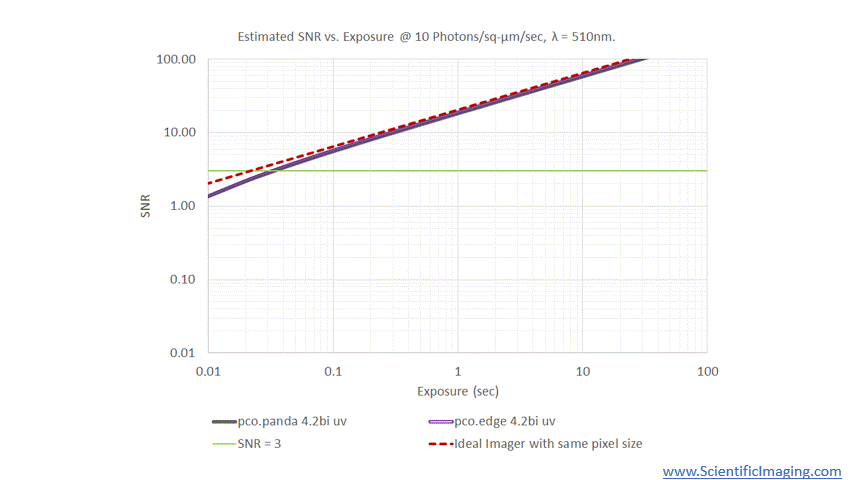The decision regarding whether to select a non-cooled or the TE-cooled camera is related to whether a user envisions that current or future experiments may involve using the camera to acquire images at very low light levels.
Summary: TE-cooling significantly lowers the dark current and hence the dark-shot-noise. In a bright-light application, it is photon-shot-noise that is the dominant noise source and not dark-shot-noise. It is not particularly useful to incur the additional cost of TE-cooling to reduce a noise source which is not dominant. A TE-cooled camera is recommended for low-light applications in which users can take advantage of long exposures.
A more detailed explanation: In the animation below the performance of a non-cooled pco.panda 4.2 bi uv is compared to the performance of the TE-cooled pco.edge 4.2 bi uv camera at photon flux densities that are reduced by a factor of 2 in each of eight steps. The same sCMOS image sensor is used in both cameras, the only difference being that the “panda” is non-cooled and the “edge” is TE-cooled. Although the example shown is that of a back-illuminated imager with a UV-window, it applies conceptually to comparisons of other cooled/non-cooled cameras as well.
An SNR=3 line is added to the graph to establish a somewhat arbitrarily selected threshold that represents a usable image. An ideal imager with QE = 100%, ZERO read noise and ZERO dark current and with the same 6.5µm pixel size as the two cameras is also included in this analysis. This helps to show the deviation in the behavior of the two real-world cameras from that of a theoretically ideal camera which experiences ONLY photon-shot-noise. Note that Photon Shot Noise is an attribute of light itself – it is not introduced by a camera. This is detailed in the article titled Photons and Photon Shot Noise.

Under relatively bright conditions the dominant noise source is photon-shot-noise and not dark-shot-noise. Consequently, there is hardly any difference between the estimated SNR vs Exposure graph of both cameras and one can typically acquire relatively high SNR images with short exposures (typically less than 500ms). Since there is no particular benefit in using a TE-cooled camera in this case, the use of a non-cooled camera is recommended.
Low light conditions are more challenging: it takes longer exposures (often greater than 1sec) to acquire images with an acceptable SNR. Under low light conditions, photon-shot-noise is a less dominant noise source in comparison with the read-noise and dark-shot-noise, both of which are noise sources introduced by the camera. At low exposures, read-noise is the dominant noise source which is why the estimated SNRs of the non-cooled and TE-cooled cameras are the same, although much below the SNR=3 threshold. At longer exposures one can observe the divergence between the estimated SNR of the TE-cooled camera and the non-cooled camera. Photon-shot-noise remains the dominant noise source in the TE-cooled camera which continues to closely track with the behavior of an ideal camera. This is because the dark current, and thus the dark-shot-noise is kept negligibly low due to the low sensor temperature. In the non-cooled camera, dark-shot-noise dominates at longer exposures, as indicated by its significant deviation from ideal-camera behavior.

